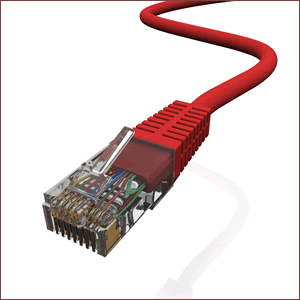How to Test an RJ45 Pinout
The way the RJ45 connector is wired to Cat 5, 5e, and 6 cables differs depending upon the type of cable required. To understand why, it’s necessary to understand how computers communicate with the network.
 RJ45 modular connectors, also known as 8P8C connectors, are used to connect computers to local area networks. The way the RJ45 connector is wired to Cat 5, 5e, and 6 cables differs depending upon the type of cable required. There are straight-through cables, crossover cables, and rollover cables. To understand why, it’s necessary to understand how computers communicate with the network.
RJ45 modular connectors, also known as 8P8C connectors, are used to connect computers to local area networks. The way the RJ45 connector is wired to Cat 5, 5e, and 6 cables differs depending upon the type of cable required. There are straight-through cables, crossover cables, and rollover cables. To understand why, it’s necessary to understand how computers communicate with the network.
PC Communication Standards
When looking at an RJ45 connector from its underside, the first pin is on the left-hand side and is called pin number 1. Computers use pins 1 and 2 to send information and pins 3 and 6 to receive information.
In order to simplify wiring, upstream devices (including switches, hubs, and routers) use pins 3 and 6 to send and pins 1 and 2 to receive information so that a PC and hub can communicate using a cable that has an identical RJ45 pinout at either end.
This is known as the medium dependent interface (MDI) configuration.
Cabling Standards
The telecommunications industry has two standards for cable RJ45 pinouts, T568A and T568B. These standards determine how each of the four pairs of colored wires is connected on the RJ45 connector:
- The four colors used on Cat 5 and 6 cables are green, orange, blue, and brown. One wire in each pair has a solid color and the other has a white stripe added.
- On T586A cables, pin 1 is white-green and pin 2 green, whereas on T586B cables, pin 1 is white-orange and pin 2 orange.
- The difference continues in that pins 3 and 6 are used for the other color. With both standards, the blue pair is always on pins 4 and 5 and the brown pair on pins 7 and 8.
T586B is the most common, although the government often uses T586A. The choice is irrelevant provided all components follow the same standard.
Straight-Through Cables
The wiring of both ends of straight-through cables is the same, and these are used to connect computers to upstream devices such as a router or hub that uses the MDI communication protocol.
Crossover Cables
A crossover cable is different in that the wiring connection at one end is to the T586A configuration and on the other the T586B configuration. This means that two similar devices can communicate with each other, so this is how to connect two computers or two switches or hubs to each other. This type of connection is known as a medium dependent interface crossover (MDI-X).
Rollover Cables
A rollover cable is one where the pinouts are reversed. Pin 1 becomes pin 8 and pin 2 becomes pin 7. This type of cable is not used in computer networks, except in very special applications.
One use is as a console cable used to configure Cisco switches and other Cisco equipment. It is never used for a network connection.
Selecting the Right Network Cable
When working on a network, it’s essential to use the same cabling standard throughout.
It is relatively easy to identify which standard is in use because:
- The orange pair is always on the left-hand side of T586B cables.
- The green pair is on the left-hand side of the less common T586A configuration.
Another way of identifying the right RJ45 pinout is to use a network cable tester.
When connecting unlike pieces of equipment, always use a straight-through cable. But if connecting two similar pieces of equipment, use a crossover cable or a crossover module. Additionally, some equipment is able to recognize when a crossover cable is needed and automatically switches the pin configuration internally so a straight-through cable can be used.
This article was contributed by Ron Vogel of T3 Innovation.
[hr]
For more on the Datacom/Telecom Market click here.
Related:
Five Things to Know About Pre-Terminated Cabling and Network Deployment




